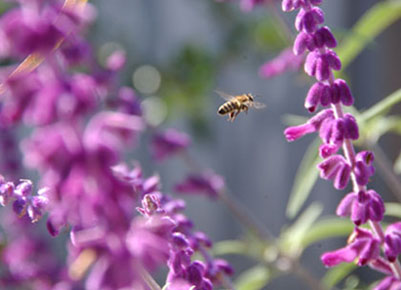
Honey bee buzzing in salvia. (Photo by Kathy Keatley Garvey)
FAQs
Here are some of the most frequently asked questions about honey bees and native bees.
1. How many kinds of bees are there?
Worldwide, there are more than 20,000 species. In addition to honey bees (Apis), the others include groups like bumble bees (genus Bombus), sweat bees (genus Halictus, among others) and carpenter bees (genus Xylocopa). In California, there are more than 1500 species of native bees.
2. What is CCD?
CCD stands for Colony Collapse Disorder. It is a mysterious phenomonen characterized by bees abandoning their hives. See news story and view lecture by Eric Mussen.
3. What is a bee swarm and how should I remove it?
See Bee Briefs
4. How can I get started in beekeeping?
See Bee Briefs
5. What's the status of Franklin's bumble bee?
See news story and view lecture by Robbin Thorp.
6. What are these big insects buzzing around in my garden that look like bumble bees?
See news story on carpenter bees.
7. What is the Honey Bee Haven?
See section page
8. Can a honey bee sting kill you?
If a person is highly sensitized to honey bee venom, one sting could be fatal, causing anaphylactic shock. Otherwise, it is just painful and likely to cause some swelling and local tenderness that will last for two or three days.
9. How do you treat a honey bee sting?
Try to remove honey bee stings as quickly as possible, since venom is pumped from a sting into the victim for 45-60 seconds. Stings are easily scraped off with a fingernail. If many honey bees are stinging, leave the area quickly and deal with the stings when you are out of range of the defensive area (about 100 feet with European honey bees, but up to ¼ mile – 1,320 feet – with Africanized honey bees). The pain can be reduced a bit by putting ice on the sting site, but the stabbing pain backs off fairly quickly without any treatment.
10. Can a honey bee hear you?
Honey bees do not have sensory organs that can pick up sounds that we can hear. They are very sensitive to vibrations. They feel us walking toward the nesting site before we get there.
11. Why do beekeepers use smokers when they visit their beehives?
The smoke from the smoker has three effects on the bees. First, it prevents the guard bees from liberating much “alarm pheromone” (smells like bananas) in the hive. Second, it prevents “soldier” bees in the hive from smelling the pheromone that has been secreted. Third, it causes many bees to fill up on honey. Despite the wives’ tales to the contrary, there is no reason to believe that the bees “think” there is a fire or that bees full of honey cannot sting.
12. Can honey bees see color?
Yes, honey bees can see nearly all the colors we see. They cannot see red, which looks black to them. They can see into the UV wavelengths a ways, which is beyond our limit at purple. UV looks black to us.
13. Do honey bees need to eat meat?
No. Unlike wasps, honey bees derive nearly all the important ingredients in their diet from pollens. Pollens contain protein, fats, vitamins, minerals, carbohydrates, sterols, and many plant-derived antioxidants. No single pollen contains all the essential ingredients, so colonies do best where a good mix of attractive flowers are available. Nectar, the dilute sugar syrup honey bees collect from flowers, contains mostly sugar, an energy food. The flavor and color of honey depend upon the source of the nectar from which it is condensed.
14. How do I register for Susan Cobey's specialized classes on "The Art of Queen Rearing," "Instrumental Insemination and Bee Breeding" and "The Advanced Workshop on Instrumental Insemination? Bee breeder-geneticist Susan Cobey is now affiliated with Washington State University. Contact her at scobey@mac.com